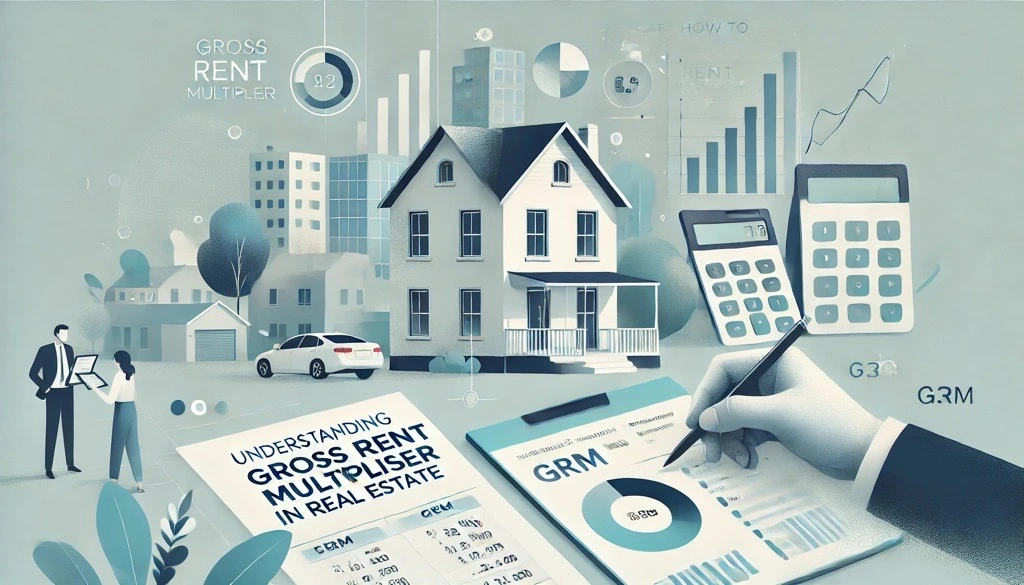What is GRM in Real Estate?
The Gross Rent Multiplier (GRM) is a measure used by real estate investors to assess properties which generates income. It offers a straightforward method for comparing the relative value of rental properties and evaluating their income potential. GRM helps in calculating the number of years required for a property to self-finance based solely on its gross rental income.
This measure is especially valuable during the initial phases of property evaluation since it is fast to compute and does not necessitate extensive financial data such as operating expenses or net income. Nevertheless, GRM should be employed as one of several instruments in a thorough real estate analysis.
GRM Real Estate: How Does It Work?
GRM is essentially the ratio between the property’s price and its gross annual rental income. It provides a snapshot of the investment’s potential return without factoring in operational costs or additional complexities.
Investors often use GRM to quickly filter properties in competitive markets. A lower GRM typically indicates a better investment opportunity because it suggests a shorter time frame to recoup the property’s purchase price through rental income.
Gross Rent Multiplier Formula
The formula for calculating GRM is straightforward:
GRM = Property Price / Gross Annual Rental Income
Here’s what each term means:
- Property Price: The total purchase price of the property, including any upfront costs.
- Gross Annual Rental Income: The total rental income the property generates in a year before deducting any expenses.
Example Calculation:
Let’s say you’re considering a property priced at $500,000 that generates $50,000 in annual rental income. Using the formula:
GRM = 500,000 / 50,000 = 10
In this example, the GRM is 10, meaning it would take 10 years for the gross rental income to equal the purchase price.
Rent Multiplier in Practice
Why Use GRM?
GRM is a useful starting point for evaluating a property’s income potential. It is especially helpful when comparing multiple properties within the same market. Investors can quickly determine which property offers better value based on gross income.
Limitations of GRM:
While GRM is a convenient tool, it has limitations. It does not account for:
- Operating Expenses: Taxes, insurance, maintenance, and property management costs can vary significantly between properties.
- Vacancy Rates: Fluctuations in occupancy can affect actual rental income.
- Market Conditions: GRM doesn’t consider market trends, appreciation potential, or location-based factors.
As a consequence, GRM ought not to be the only factor in your investment decision. Always supplement it with additional metrics such as the capitalization rate (cap rate), cash-on-cash return, and net operating income (NOI).
What is a Good Gross Rent Multiplier?
Establishing a “good” GRM is contingent on multiple aspects, including location, market dynamics, and your investment approach.
General Benchmarks:
- Low GRM (4–10): Typically considered favorable as it suggests the property will pay for itself quickly. However, a very low GRM might indicate high risk or poor property condition.
- High GRM (12+): Often seen in high-demand areas where property prices are inflated. While these properties may appreciate over time, they may offer lower immediate returns.
Market-Specific Factors:
- Urban Areas: Properties in metropolitan regions tend to have higher GRMs due to high property prices.
- Suburban or Rural Areas: GRMs are generally lower in these regions, offering better immediate returns but potentially slower appreciation.
Aligning with Investment Goals:
If you prioritize long-term appreciation, you might accept a higher GRM. Conversely, if you’re focused on cash flow, a lower GRM is preferable. Always balance GRM with your financial goals and risk tolerance.
Complementing GRM with Other Metrics
While GRM is a valuable starting point, it should not be used in isolation. Here’s how to incorporate it with other metrics:
- Cap Rate: Measures the property’s net income as a percentage of its price. This accounts for operating expenses, offering a more detailed financial picture.
- Cash-on-Cash Return: It Evaluates the annual cash flow relative to the initial investment, which helps assess profitability.
- Debt Service Coverage Ratio (DSCR): Ensures the property generates enough income to cover loan payments.
When you combine these metrics with GRM it provides a comprehensive view of a property’s investment potential.
More From Author: Netflix Metaflow
Key Takeaways for Real Estate Investors
The Gross Rent Multiplier (GRM) is a quick and efficient tool for analyzing rental properties and comparing their potential profitability. While a lower GRM is generally better, investors must consider other factors such as operating expenses, market trends, and long-term appreciation.
By complementing GRM with metrics like the cap rate and cash-on-cash return, you can make more informed investment decisions.
FAQs About Gross Rent Multiplier
Is GRM the same as cap rate?
No, GRM and cap rate are different metrics. GRM uses gross rental income without considering expenses, while the cap rate evaluates net income and includes operating costs.
How is GRM useful for beginners?
GRM is easy to calculate and understand, making it an excellent starting point for new investors to compare rental properties.
Can a high GRM still be a good investment?
Yes, in high-demand areas, properties with a high GRM might offer lower immediate returns but greater long-term appreciation potential.
What’s the difference between gross and net income in GRM calculations?
GRM uses gross income (total rental income before expenses), whereas other metrics like NOI use net income (income after deducting expenses).
How can I improve the GRM of a property I own?
Improving GRM can be achieved by increasing rental income, such as by upgrading amenities, or by reducing the property’s purchase price during negotiation.






